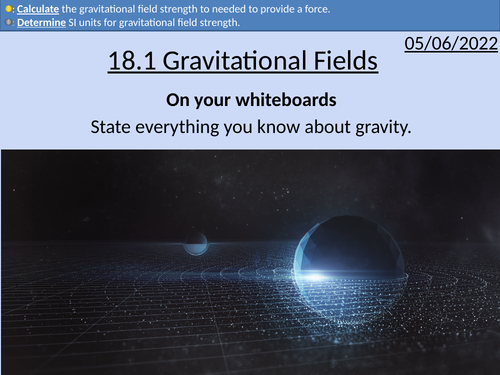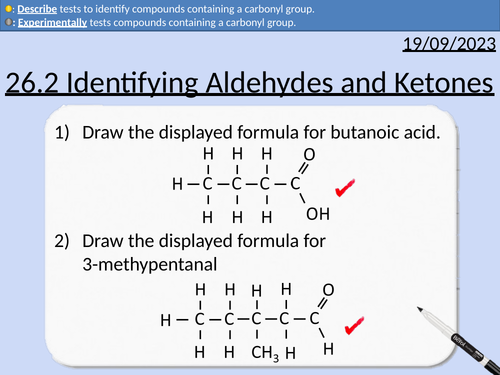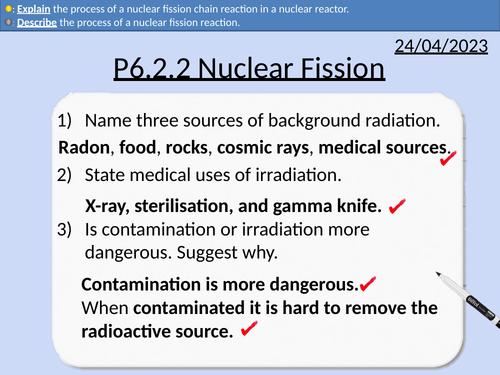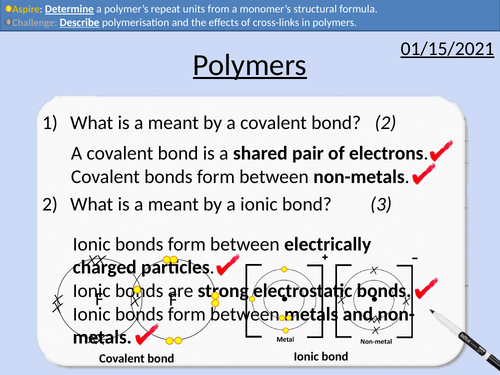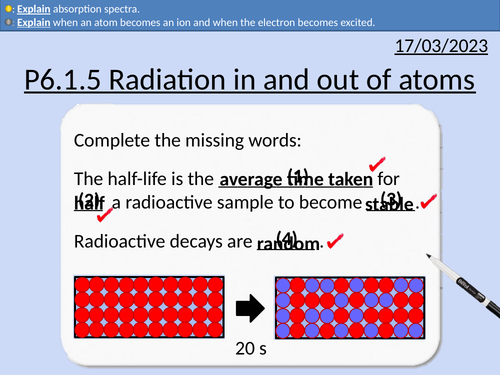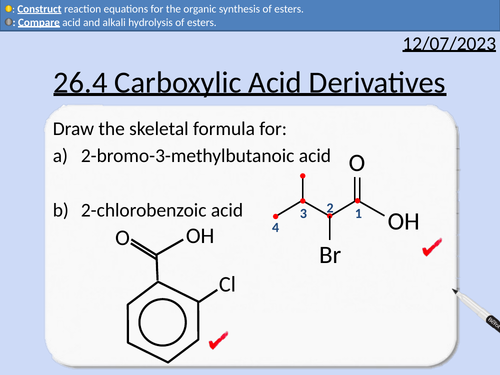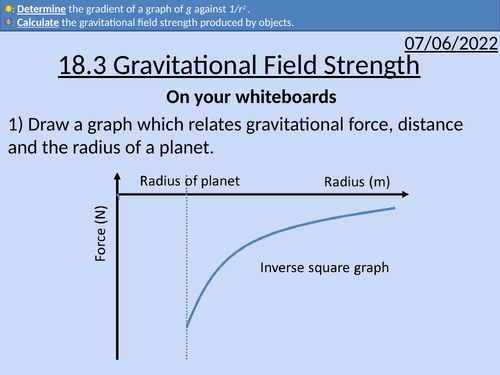449Uploads
137k+Views
61k+Downloads
All resources
Bundle

GCSE OCR Physics P4 Magnetism
All resources for P4 Magnetism and Magnetic Fields for GCSE OCR Physics Gateway 9-1.Triple and combined (Higher and Foundation) is covered in this material.
• Magnets and Magnetic Fields
• Currents and Fields
• Right Hand Cork-screw Rule
• Fleming’s Left Hand Rule
• Currents and Forces
• Motors
• Electromagnetic Induction
• Generators
• Transformers
• Speakers and Microphones
Bundle

OCR AS level Physics: Foundations of Physics
OCR AS level Physics presentations for module 2: Foundations of Physics.
All presentations come with worked examples, solutions and homeworks.
This covers topics from SI units to vector analyis with sine and cosine rules.
Bundle

OCR A level Physics: Ideal Gas
OCR A level Physics: Ideal Gas is a part of the Module 5: Newtonian World and Astrophysics.
All presentations come with worked examples, solutions and homeworks.

OCR A Level Physics: Gravitational Fields
OCR A Level Physics: Gravitational Fields presentation, homework and answers.
Bundle

OCR A level Chemistry: Amines, Amino Acids, and Polymers
OCR A level Chemistry: Aromatic Compounds is apart of the Module 6: Organic Chemistry and Analysis.
All presentations come with worked examples, solutions and homeworks.
27.1 Amines
27.2 Amino acids, Amides and Chirality
27.3 Condensation Polymers
Aliphatic and aromatic hydrocarbons
Amines being derived from ammonia (NH3)
Classifying amines as primary, secondary, and tertiary
Naming amines
Naming ammonium salts
Amines neutralisation reactions with acids
Preparation of aliphatic amines
Preparation of aromatic amines
Locants: alpha, beta, and gamma
Functional groups of amino acids
General formula for amino acids
Reactions of amino acids (alkali and acid)
Esterification of amino acids
Amide functional groups
Naming amide molecules
Drawing optical isomers
Explanation of superimposable and non-superimposable images
Identifying chiral centers
Recap of addition polymerisation
Identifying monomers and repeat units from condensation polymers
Polyesters and ester links
Polyamides and amide links
Polyesters and polyamides formed from one monomer
Polyesters and polyamide formed from two monomers
Alkali hydrolysis of polyamides and polyesters
Acid hydrolysis of polyamides and polyesters

A level Chemistry: Identifying Aldehydes and Ketones
OCR A level Chemistry: 26.2 Identifying Aldehydes and Ketones
This PowerPoint is a whole lesson included with student activities, animated answers, homework questions with answers provided.
This lesson covers:
Testing for Carbonyl Groups
Brady’s reagent - 2,4-dinitrophenylhydrazine - 2,4-DNP
Distinguishing between Aldehydes and Ketones
Tollen’s reagent - silver nitrate in aqueous ammonia

GCSE Chemistry: Bond Energies and Energy Changes
This PowerPoint presentation with worked examples and student questions covers:
• Definition of bond energies
• Calculating bond energies per mole
• Calculating change in bond energies in reactions
• Determining if a reaction is exothermic or endothermic from the change in bond energy.

A level Chemistry: Proton NMR Spectroscopy
OCR A level Chemistry: 29.4 Proton NMR Spectroscopy
This PowerPoint is a whole lesson included with student activities, animated answers, homework questions with answers provided.
This lesson covers:
Identifying the number of different proton environments
Identifying the types of proton environment and chemical shifts
Integration traces (area of peaks) and relative number of protons
The spin-spin splitting pattern (n + 1)

GCSE Physics: Forces and Fleming's Left Hand Rule
This presentation covers OCR Gateway Physics 9-1 P4.2.1 Forces, Current and Fleming’s Left Hand Rule.
This presentation includes:
Interacting Magnetic Field Lines
Increasing Magnitude of the force on a current carrying conductor
Applying Fleming’s Left Hand Rule
Bundle

GCSE OCR Physics: P7.2 Power and Efficiency
All resources for P7.2 P7.2 Power and Efficiency GCSE OCR Physics Gateway 9-1. Triple and combined (Higher and Foundation) is covered in this material.
All powerpoints include student activities and worked examples.
Electrical Work Done
Paying for Electricity
Electrical Energy Transfers
Electrical Heating
Thermal Conductivity
Efficiency and Sankey Diagrams

GCSE Physics: Nuclear Fission
This presentation covers OCR Gateway Physics 9-1 P6.2.2 Nuclear Fission
This PowerPoint is a whole lessons included with student activities and animated answers.
Conservation of mass
Uranium as a nuclear fission fuel
Nuclear fission process
Chain reactions in nuclear fission reactions
Control rods and moderators in nuclear reactors
Benefits and disadvantages of nuclear fission reactors.
Mass-Energy Equivalence

GCSE Chemistry: Thin Layer and Gas Chromatography
This PowerPoint presentation with worked examples and student questions covers:
• Experimental Procedure for Thin Layer Chromatography
• Analysing and calculating Rf Values
• Pros and cons of paper and TL chromatography
• Experimental procedure for Gas Chromatography
• Persuasive writing and embedding literacy in science

GCSE Chemistry: Polymers
This PowerPoint presentation with worked examples and student questions covers:
• State what is meant by mono- and poly-.
• Describe polymerisation and the effects of cross-links in polymers.
• Determine a polymer’s repeat units from a monomer’s structural formula.

GCSE Physics: Absorption and Emission Spectra
This presentation covers OCR Gateway Physics 9-1 P6.1.5 Radiation in and out of atoms.
This PowerPoint is a whole lessons included with student activities and animated answers.
Arrangements of electrons and distance from the nucleus
Electron energy levels
Absorbing electromagnetic radiation
Electromagnetic radiation and energy
Absorption spectra
Emission spectra
Discovery of helium
Bundle

GCSE OCR Physics: P6 Radiation
All resources for GCSE OCR Physics Gateway 9-1 P6 Radiation.
Triple and combined (Higher and Foundation) is covered in this material.
Atoms and Isotopes
Alpha, Beta, and Gamma Radiation
Nuclear Equations
Half-life
Radiation and the body
Nuclear Fusion
Nuclear Fission
Radiation in and out of atoms

A level Chemistry: Carboxylic Acid Derivatives
OCR A level Chemistry: 26.3 Carboxylic Acids
This PowerPoint is a whole lesson included with student activities, animated answers, homework questions with answers provided.
This lesson covers:
Naming acyl chlorides
Naming acid anhydrides
Naming esters
Esterification
Acid hydrolysis of esters
Alkali hydrolysis of esters
Producing acyl chlorides from carboxylic acids
Producing carboxylic acids from acyl chlorides
Producing esters from acyl chlorides and phenols
Primary, secondary, and tertiary molecules
Producing primary amides from acyl chlorides
Producing secondary amides with acyl chlorides
Producing esters and carboxylic acids wirh acid anhydride
Bundle

OCR A level Chemistry: Organic Synthesis
OCR A level Chemistry: Organic Synthesis is apart of the Module 6: Organic Chemistry and Analysis.
All presentations come with worked examples, solutions and homeworks.
28.1 Carbon-Carbon Bond Formation
28.2 Further Practical Techniques
28.3 Further Synthetic Routes
Forming nitriles from haloalkanes
Forming nitriles from aldehydes and ketones
Forming amines from nitriles (reduction)
Forming carboxylic acids from nitriles (hydrolysis)
Friedel-Crafts alkylation of benzene
Acylation of benzene with acyl chloride
Filtration under reduced pressure
Purification through Recrystallisation
Preparation of Melting Point Sample
Melting point determination with an electric heater
Melting point determination with a Thiele tube
Functional groups
Reactions of benzenes
Reactions of phenols
Common reactions between different functional groups
Reaction conditions and reagents
Bundle

OCR A level Physics: Cosmology (Big Bang)
OCR A level Physics: Chapter 20 Cosmology (Big Bang) is apart of the Module 5: Newtonian world and Astrophysics.
All presentations come with worked examples, solutions and homeworks.
20.1 Astronomical Distances
20.2 The Doppler Effect
20.3 Hubble’s Law
20.4 The Big-bang Theory
20.5 Evolution of the Universe
Astronomical distances: light-years, parsec, astronomical unit
Astronomical angles - degree, arcminute, arcsecond
Parallax Angle
The definition of the Doppler effect
Changes in pitch of sound waves due to relative motion
Absorption spectra and electron energy levels
Red-shift and blue-shift absorption spectra
The Doppler equation
The condition for velocity for the Doppler equation
The Cosmological Principle
Hubble’s Observations
Hubble’s Law
Hubble’s constant and the gradient of a graph
Converting between km s-1 Mpc-1 into s-1
The expanding Universe model.
Georges Lemaître’s Theory
Evidence for the Big Bang Model
Hubble’s Law (expanding Universe)
Microwave Background Radiation
Source of the Microwave Background Radiation
Hubble’s constant and the age of the Universe
The evolution of the Universe from the Big-bang to 13.7 billion years later
The composition of the Universe
Experimental evidence for dark matter
Experimental evidence for dark energy

OCR A Level Physics: Gravitational Potential
OCR A level Physics: 18.6 Gravitational Potential
Module 5 Newtonian World and Astrophysics
This PowerPoint is a whole lesson included with student activities, animated answers, homework questions with answers provided.
This lesson covers:
Center of mass and treating spherical objects as point masses
Gravitational fields
Definition of gravitational potential
Applying the gravitational potential equation
Graph of gravitational potential against distance (V against r)
Combining gravitational potentials from more than one mass

OCR A Level Physics: Gravitational Field Strength
OCR A Level Physics: Gravitational Field Strength presentation with homework and answers




